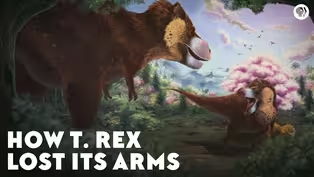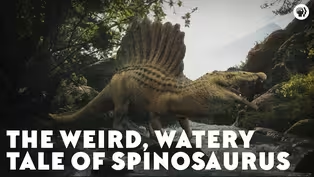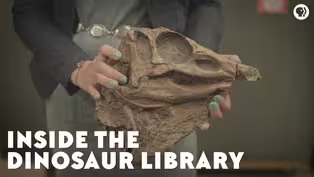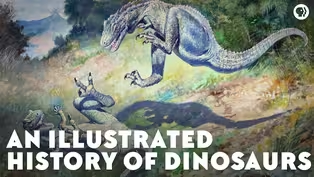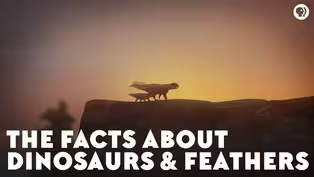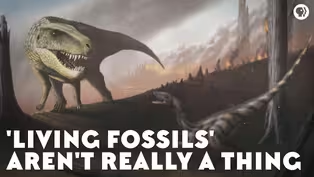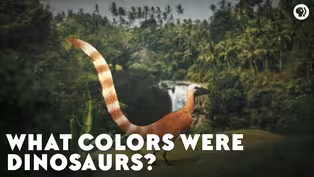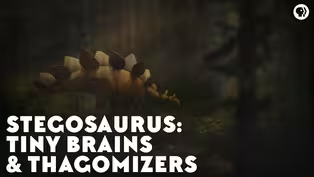
How Did Dinosaurs Get So Huge?
Season 1 Episode 14 | 5m 42sVideo has Closed Captions
Creatures as tall as a five-story buildings shook the Earth.
Part of why we’re so fascinated with extinct dinosaurs it’s just hard for us to believe that animals that huge actually existed. And yet, they existed! From the Jurassic to the Cretaceous Periods, creatures as tall as a five-story building were shaking the Earth.
Problems playing video? | Closed Captioning Feedback
Problems playing video? | Closed Captioning Feedback

How Did Dinosaurs Get So Huge?
Season 1 Episode 14 | 5m 42sVideo has Closed Captions
Part of why we’re so fascinated with extinct dinosaurs it’s just hard for us to believe that animals that huge actually existed. And yet, they existed! From the Jurassic to the Cretaceous Periods, creatures as tall as a five-story building were shaking the Earth.
Problems playing video? | Closed Captioning Feedback
How to Watch Eons
Eons is available to stream on pbs.org and the free PBS App, available on iPhone, Apple TV, Android TV, Android smartphones, Amazon Fire TV, Amazon Fire Tablet, Roku, Samsung Smart TV, and Vizio.
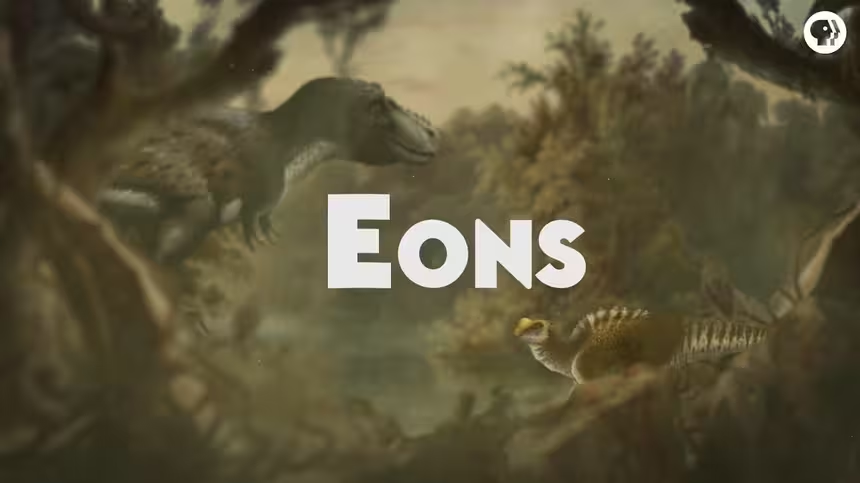
Welcome to Eons!
Join hosts Michelle Barboza-Ramirez, Kallie Moore, and Blake de Pastino as they take you on a journey through the history of life on Earth. From the dawn of life in the Archaean Eon through the Mesozoic Era — the so-called “Age of Dinosaurs” -- right up to the end of the most recent Ice Age.Providing Support for PBS.org
Learn Moreabout PBS online sponsorshipMore from This Collection
Video has Closed Captions
Tyrannosaurus rex had tiny arms. How did this happen, and why did it keep them? (6m 54s)
The Weird, Watery Tale of Spinosaurus
Video has Closed Captions
In 1912, a fossil collector discovered the world’s only known semi-aquatic dinosaur. (7m 28s)
Video has Closed Captions
We talk to Amy Atwater, Collections Manager at the Museum of the Rockies. (7m 19s)
An Illustrated History of Dinosaurs
Video has Closed Captions
Our image of dinosaurs has been constantly changing since naturalists started studying the (12m 20s)
The Facts About Dinosaurs & Feathers
Video has Closed Captions
Dinosaurs have been found with some sort of fluff or even full-on plumage. (10m 1s)
Living Fossils' Aren't Really a Thing
Video has Closed Captions
Even the most ancient-looking organisms show us that evolution is always at work. (5m 5s)
Video has Closed Captions
We know a lot about dinosaurs but there’s one question that has plagued paleontologists.. (5m 2s)
Stegosaurs: Tiny Brains & Thagomizers
Video has Closed Captions
If you take it as a given that extinct dinosaurs were all weird and wonderful, then you go (4m 49s)
Providing Support for PBS.org
Learn Moreabout PBS online sponsorshipPart of why we're so fascinated with extinct dinosaurs, I think, is that some of them were just so big, it's just hard to imagine animals walking around on the surface of the planet that size Speaking as a mammal that's about two meters tall, I gotta say it's hard to grasp what it would be like, to be in the presence of a creature as tall as a five-story building.
And yet, they existed!
From the Jurassic to the Cretaceous Periods, when our ancestors were the size of voles and shrews, dinosaurs like Supersaurus, Sauroposeidon, and Argentinosaurus were shaking the Earth.
So, how did they get to be so big?
And why did we mammals never even come close to dinosaurs in size?
Well, to our credit, the most massive animal ever is, of course, a mammal: the blue whale.
It can get up to 30 meters long and weigh as much as 145 metric tons -- more than twice as heavy as the most massive known dinosaur.
But, to be fair, the rules of biomechanics are different in the water.
Buoyancy and blubber can do amazing things, allowing sea creatures to grow to sizes that would be impossible on land.
However, when it comes to the largest terrestrial animals, mammals were never any competition for the non-avian dinosaurs.
There's always some debate about what the biggest dinosaur was.
But the current record holder for the largest specimen belongs to the newly-named titanosaur Patagotitan.
Experts estimate that this Cretaceous herbivore stretched over 36 and a half meters, and weighed upward of 64 metric tons.
By contrast, the biggest mammal that ever walked on land was the hornless rhinoceros known as Paraceratherium.
It weighed a mere 15 tons, and stood about 5 meters high at the shoulder, roaming Eurasia from Romania to China, at the end of the Oligocene Epoch, long after the non-avian dinosaurs disappeared.
So, how can two such successful and prolific types of animals end up having such different size constraints?
Part of it might have to do with how they reproduced.
Paraceratherium was a placental mammal, like us, meaning that it gestated its young inside its body.
And if this ancient rhino was anything like the large mammals alive today, that would've taken a very long time.
Big mammals like giraffes, rhinos, and elephants usually have only one offspring at a time, and gestation can last longer than some other kinds of animals live.
Elephants, for example, carry their babies for more than two years!
Now consider the dinosaurs.
They didn't really have to carry their babies at all.
Because, all dinosaurs laid eggs.
Even the biggest of the giant dinos hatched from an egg no bigger than a soccer ball.
What does this have to do with size?
Well, bigger mammal species give birth to bigger young, which requires a huge amount of time and energy to gestate.
Dinosaurs totally bypassed that problem.
Instead of having bigger babies, the largest dinosaurs laid comparatively small eggs, which held equally small hatchlings.
Reproducing this way - with babies hatching and growing outside the mother's body - removed the size limits that gestation places on mammals.
Dinosaurs also had another evolutionary advantage.
Their skeletons had a special feature that mammals lacked: a sophisticated system of air sacs.
These sacs were basically pockets of soft tissue that were connected to the lungs.
Think of them as biological balloons.
Some of these sacs sat in the body cavity, next to bones, usually in the neck, back, and hips.
But others ran inside the bones themselves.
These air sacs helped shape the dinosaur's skeleton, and allowed the bones of the biggest dinosaurs to remain light, without sacrificing strength.
How do we know that extinct dinosaurs had these sacs?
Partly, because non-extinct dinosaurs have them too!
Birds have a similar system of sacs that help draw air into their tiny lungs, while also making their skeletons remarkably light.
And if you compare the respiratory system of birds to those of the giant dinos, you'll see that the resemblance is pretty striking.
In sauropods, for example, the vertebrae of the neck and back have the same pockets and divots we find in birds today, where these air sacs were attached.
And, when paleontologists scan fossils of some dinosaur bones, like vertebrae, they often find hollow spaces inside the bones where the air sacs used to sit.
Now, keep in mind that bones with spaces created by air sacs are different from the hollow bones that you see in the legs of birds and other theropod dinosaurs.
And, not all of the extinct dinosaurs had these handy air bags.
Only the type of dinos known as saurischians had them.
In the traditional dinosaur family tree, this group encompasses the theropods -- that is, the two-legged dinosaurs that include today's birds -- as well as the sauropods, the quadrupeds that include the giant titanosaurs.
All of the rest of the dinosaurs -- like the horned, armored, and duckbilled dinosaurs - - are known as ornithischians, and they didn't have these features, so they weren't as light on their feet.
And of course, we mammals don't have anything like them, either.
We retained a skeletal system of dense, heavy bones that puts a limit on how big we can get before our bones crack under our own weight.
But the thing is, these adaptations are just what allowed dinosaurs to get so big.
They don't tell us why these giants all got so enormous in the first place!
And that's a totally different evolutionary question, with lots of possible answers.
Maybe living large was a way to stay safe from predators.
Or maybe their size allowed dinosaurs to cover more ground, or reach higher leafy branches, in search of food.
Or maybe there's something paleontologists haven't thought of yet.
And then there's another question to consider: Was the ability to grow so large really an advantage?
After all, the sauropods are gone.
So are most of their relatives.
Of the entire dinosaur family, only birds - - a single group of saurischian theropods - - survives, and they range in size from the hummingbird to the ostrich.
So, today, even if it's hard for us to picture a dinosaur as huge as Patagotitan, we can at least understand how animals like it were physically possible.
Perhaps we're lucky that we never reached such great heights.
Evolutionarily speaking, it seems that bigger is not always better.

- Science and Nature

A series about fails in history that have resulted in major discoveries and inventions.













Support for PBS provided by:

